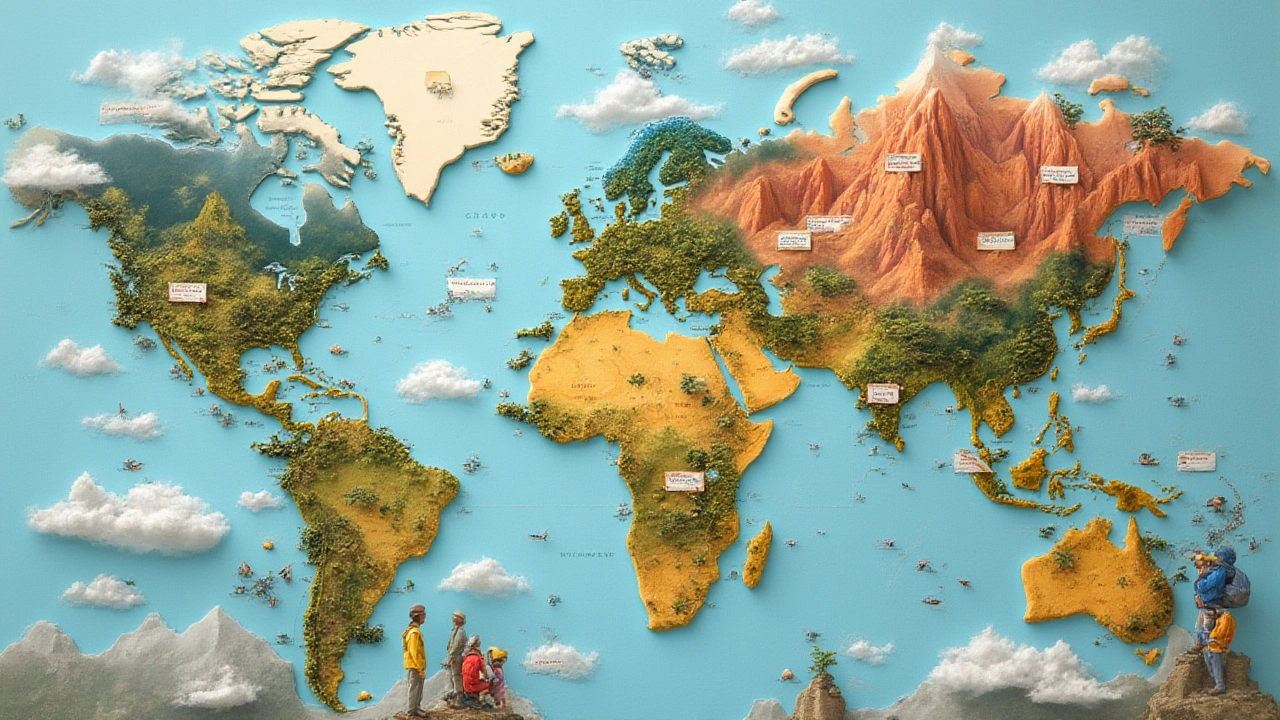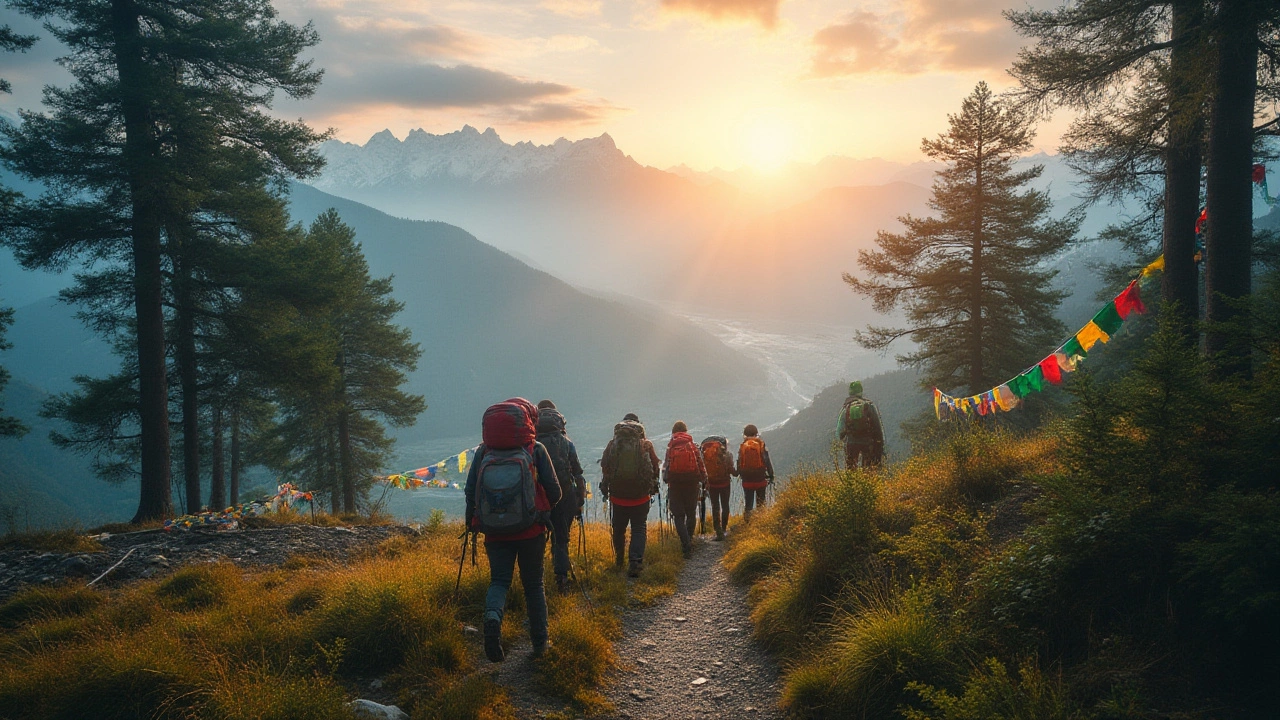Ask ten hikers where to find the best hiking in the world, and you'll get at least twelve different answers. That’s the fun thing about this: there’s no universal list, no all-knowing “hiker’s bible.” Some folks feel most alive scrambling up Himalayan ridges, while others would trade a summit view for cool twilight walks through rainforests. But there are some places that just keep drawing people back, with wild stories, record-setting views, or trails that have somehow earned legendary status over the years.
Iconic Trails and Legendary Peaks
Let’s start with the classics: the spots even non-hikers have heard about. The Inca Trail to Machu Picchu in Peru is a big one. This four-day trek is steeped in history, with misty mountains and ancient ruins scattered along the path. The Peruvian government limits daily hiker numbers for conservation, so you get a more peaceful journey—if you can snag a spot. Another old-school favorite is the Appalachian Trail in the United States, stretching about 3,500km from Georgia to Maine. Some take six months to thru-hike it, others do a few days. Most join the “AT” for its community spirit—trail angels, hiker towns, and the feeling that you’re part of some quirky, muddy family.
Jump across to Nepal and the Everest Base Camp trek. You don’t need to be a mountaineer or a millionaire to get close to the top of the world. About 40,000 people each year walk these rugged paths, winding through Sherpa villages, prayer flags, and glacial valleys. The air gets thinner, but the stories get thicker. For those who like extremes, the Torres del Paine “W” Circuit in Chile’s Patagonia is basically outdoor catnip: turquoise lakes, granite spires poking up like a dragon’s back, and gusts of wind strong enough to knock you down (seriously, the wind has a reputation of its own).
Even if you stare at these names and think, “All I want is a peaceful woodland walk,” there’s space for you too. The West Highland Way in Scotland is legendary for its lush green hills, ancient lochs, and the ever-present threat of rain sneaking up on you. And, closer to home if you’re reading from the UK, Snowdonia in Wales punches above its weight in the drama department, with craggy peaks and mist that rolls in like something out of an old ghost story.
Surprising Gems: Trails That Deserve More Hype
The famous treks get most of the headlines, but let’s be honest: fame usually means crowds and high prices. If you’re itching for something less commercial but still unforgettable, you’re in luck. The Laugavegur Trail in Iceland looks like it was scribbled straight out of a fantasy novel: lava fields, steaming hot springs, neon-green moss, and black sand deserts. There are river crossings that’ll chill your toes, but the reward is hot-spring soaks under open sky.
Jump down to Africa for the Simien Mountains in Ethiopia. The peaks here don’t just rise, they explode upwards—massive cliffs, unique wildlife like the gelada monkey, and giant lobelias you’d swear came straight out of Jurassic Park. Next up: New Zealand. The Milford Track is nicknamed “the finest walk in the world,” and for good reason. Misty valleys, towering waterfalls, and silent beech forests form a backdrop so beautiful you might never want to leave.
If you’d rather hike with no one in sight, try the Great Himalaya Trail. Spanning 1,700km across Nepal, it connects remote villages, technical passes, and all the wild unpredictability that makes travel feel like true adventure. It’s not for beginners, and local guiding experience is a must, but that challenge is exactly what serious trekkers chase.
Sometimes, hidden gems are right under our noses. Madeira, Portugal, is a magnet for hikers who love subtropical forests and sky-high ridge walks just a few hours from mainland Europe. The Levada walks (following ancient irrigation channels) give you shade, greenery, and a whole lot of solitude. Locals know it’s a secret, and they’re not in a hurry to change that.

What Makes a Place the Best for Hiking?
Here’s where it gets tricky. “Best” is different for everyone. Does the perfect hike mean wildlife sightings, glacier views, historic stories, or just warm sun and a flat trail? For some, it’s about the sheer variety—Switzerland’s Bernese Oberland might not offer jungle treks or sand dunes, but you can hop from valley to peak on world-class paths, munching cheese and chocolate between switchbacks.
Weather is a massive factor. Did you know the GR20 in Corsica is famous for stunning granite ridges and Mediterranean sun, but it can also smack you with huge storms? Or that trails in the Canadian Rockies, like the Skyline Trail, have windows for wildflower meadows one month, snowy sunrises the next? If you love wildlife, head for Tanzania’s Mount Kilimanjaro—zebra and elephant roam the lower slopes before you work your way through five climate zones to reach snowy Uhuru Peak.
For history-lovers, Italy’s Cinque Terre is hard to top: colorful seaside villages, ancient vineyards, and hiking paths that medieval traders once walked. If you’re drawn by a sense of connection, Japan’s Kumano Kodo traces routes that emperors and pilgrims have followed for over a thousand years. Bamboo forests, mossy shrines, and steaming onsens work their healing magic for tired feet.
Then there’s the challenge level. Some want easy rambles, others need lungs burning and legs shaking. Peru’s Cordillera Blanca unleashes heart-pounding elevation climbs, but the payoff is string after string of ice-blue lakes and wild, toothy peaks. North America’s Pacific Crest Trail covers deserts, volcanoes, and snowy passes—for many, it’s about proving something to themselves, not just checking boxes.
Tips for Choosing Your Own Best Hiking Place
Here’s the real secret: the best hiking places are often personal discoveries. Maybe you’re tired of crowded Insta-famous trails. Maybe you want an adrenaline hit, or just some headspace with no Wi-Fi. A few tips can make the adventure feel like your own:
- Know your limits. Don’t get bullied by glossy guidebooks. If you prefer flat paths and tea stops, seek out gentle walks rather than forcing yourself up Everest Lite.
- Check local rules and permits. Many of the greats—think Inca Trail, Yosemite’s Half Dome, or Bhutan’s Snowman Trek—now have strict permit systems. Research before booking flights.
- Ask locals. Some of the most jaw-dropping trails aren’t in any guide. In Norway, small villages often have secret routes to fjord overlooks. Chat up the cafe owner or your hostel host.
- Go in the shoulder season. Marquee trails are often packed in high summer. For more space and better light for photography, try late spring or early autumn.
- Pack for surprises. Lightweight rain jackets, water filters, and sturdy boots matter more than fancy gear brands. In the Dolomites, Italians walk in trainers and smiles half the time.
- Be kind to the trail. Follow Leave No Trace—it’s not corny, it’s responsible. Trash in, trash out, and leave wildflowers for the next hiker’s eyes, not your vase.
If you’re curious about how these places stack up by the numbers, check this handy table for reference:
| Destination | Main Feature | Length (km) | Avg. Hiker Days | Best Season |
|---|---|---|---|---|
| Inca Trail (Peru) | Ancient Ruins | 43 | 4 | May - Sept |
| Appalachian Trail (USA) | Wild Forests | 3,500 | 150-180 | Apr - Sept |
| Everest Base Camp (Nepal) | Himalayan Views | 130 | 12 | Mar - May/Sept - Nov |
| Laugavegur Trail (Iceland) | Geothermal Scenery | 55 | 5 | June - Aug |
| Torres del Paine W (Chile) | Patagonian Peaks | 80 | 5 | Nov - Mar |
| Kumano Kodo (Japan) | Pilgrimage Trail | 70 | 4 | Mar - May/Sept - Nov |
So, what gets your heart racing? I’ve met hikers who swear by sunrise on a Scottish moor, and others who’ll never forget thunder rolling through Rocky Mountain passes. The truth: the best hiking place is the one that leaves you grinning at the finish, hungry for the next trail. Don’t just trust the internet’s Top 10 lists or even my word—lace up, head out, and start your own shortlist. Some trails are legends for a reason, but your best hike might not even have a name on the map...yet.
